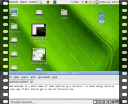Warning: Long, technical post
One of the few remaining icky areas of the Nautilus codebase is the metadata store. Its got some weird inefficient XML file format, the code is pretty nasty and its the data is not accessible to other apps. Its been on my list of things to replace for quite some time, and yesterday I finally got rid of it.
The new system is actually pretty cool, both in the API to access is how it works internally. So, I’m gonna spend a few bits on explaining how it works.
Lets start with the requirements and then we can see how to fulfil these. We want:
- A generic per-file key-value store with string and string list values. (String lists are required by Nautilus for e.g. emblems)
- All apps should be able to access the store for both writing and reading.
- Access, in particular read access, needs to be very efficient, even when used in typical I/O fashion (lots of small calls intermixed with other file I/O). Getting the metadata for a file should not be significantly more expensive than a stat syscall.
- Removable media should be handled in a “sane” way, even if multiple volumes may be mounted in the same place.
- We don’t require transactional semantics for the database (i.e. no need to guarantee that a returned metadata set is written to stable storage). What we want is something I call “desktop transaction semantics”.
By this I means that in case of a crash, its fine to lose what you changed in the recent history. However, things that were written a long time ago (even if recently overwritten) should not get lost. You either get the “old” value or the “new” value, but you never ever get neither or a broken database. - Homedirs on NFS should work, without risking database corruption if two logins with the same homedir write concurrently. It is fine if doing so may lose some of these writes, as long as the database is not corrupted. (NFS is still used in a lot of places like universities and enterprise corporations.)
Seems like a pretty tall order. How would you do something like that?
Performance
For performance reason its not a good idea to require IPC for reading data, as doing so can block things for a long time (especially when data are contended, compare i.e. with how gconf reads are a performance issue on login). To avoid this we steal an idea from dconf: all reads go through mmaped files.
These are opened once and the file format in them is designed to allow very fast lookups using a minimal amount of page faults. This means that once things are in a steady state lookup is done without any syscalls at all, and is very fast.
Writes
Metadata writes are a handled by a single process that ensures that concurrent writes are serialized when writing to disk.
Clients talk to the metadata daemon via dbus. The daemon is started automatically by dbus when first used, and it may exit when idle.
Desktop Transaction semantics
In order to give any consistancy guarantees for file writes fsync() is normally used. However this is overkill and in some cases a serious system performance problem (see the recent ext3/4 fsync discussion). Even without the ext3 problem a fsync requires a disk spinup and rotation to guarantee some data on disk before we could return a metadata write call, which is quite costly (on the order of several milliseconds at least).
In order to solve this I’ve made the file format for a single database be in two files. One file is the “tree” which contains a static, read only, metadata tree. This file is replaced using the standard atomic replace model (write to temp, fsync, rename over).
However, we rarely change this file, instead all writes go to another file, the “journal”. As the name implies this is a journal oriented format where each new operation gets written at the end of the journal. Each entry has a checksum so that we can validate the journal on read (in case of crash) and the journal is never fsynced.
After a timeout (or when full) the journal is “rotated”, i.e. we create a new “tree” file containing all the info from the journal and a new empty journal. Once something is rotated into the “tree” it is generally safe for long term storage, but this slow operation happens rarely and not when a client is blocking for the result.
NFS homedirs
It turns out that this setup is mostly OK for the NFS homedir case too. All we have to do is put the log file on a non-NFS location like /tmp so that multiple clients won’t scribble over each other. Once a client rotates the journal it will be safely visible by every client in a safe fashion (although some clients may lose recent writes in case of concurrent updates).
There is one detail with atomic replace on NFS that is problematic. Due to the stateless nature of NFS an open file may be removed on the server by another client (the server don’t know you have the file open), which would later cause an error when we read from the file. Fortunately we can workaround this by opening the database file in a specific way[1].
Removable media
The current Nautilus metadata database uses a single tree based on pathnames to store metadata. This becomes quite weird for removable media where the same path may be reused for multiple disks and where one disk can be mounted in different places. Looking at the database it seems like all these files are merged into a single directory, causing various problems.
The new system uses multiple databases. libudev is used to efficiently look up the filesystem UUID and label for as mount and if that is availible use that as the database id, storing paths relative to that mount. We also have a standard database for your homedir (not based on UUID etc, as the homedir often migrates between systems, etc) and a fall-back “root” database for everything not matching the previous databases.
This means that we should seamlessly handle removable media as long as there are useful UUIDs or labels and have a somewhat ok fall-back otherwise.
Integration with platform
All this is pretty much invisible to applications. Thanks to the gio/GVfs split and the extensible gio APIs things are automatically availible to all applications without using any new APIs once a new GVfs is installed. Metadata can be gotten with the normal g_file_query_info() calls by requesting things from the “metadata” namespace. Similar standard calls can be used to set metadata.
Also, the standard gio copy, move and remove operations automatically affect the metadata databases. For instance, if you move a file its metadata will automatically move with it.
Here is an example:
$ touch /tmp/testfile $ gvfs-info -a "metadata::*" /tmp/testfile attributes: $ gvfs-set-attribute /tmp/testfile metadata::some-key "A metadata value" $ gvfs-info -a "metadata::*" /tmp/testfile attributes: metadata::some-key: A metadata value $ gvfs-copy /tmp/testfile /tmp/testfile2 $ gvfs-info -a "metadata::*" /tmp/testfile2 attributes: metadata::some-key: A metadata value
Relation to Tracker
I think I have to mention this since the Tracker team want other developers to use Tracker as a data store for their applications, and I’m instead creating my own database. I’ll try to explain my reasons and how I think these should cooperate.
First of all there are technical reasons why Tracker is not a good fit. It uses sqlite which is not safe on NFS. It uses a database, so each read operation is an IPC call that gets resolved to a database query, causing performance issues. It is not impossible to make database use efficient, but it requires a different approach than how file I/O normally looks. You need to do larger queries that does as much as possible in one operation, whereas we instead inject many small operations between the ordinary i/o calls (after each stat when reading a directory of files, after each file copy, move or remove, etc).
Secondly, I don’t feel good about storing the kind of metadata Nautilus uses in the Tracker database. There are various vague problems here that all interact. I don’t like the mixing of user specified data like custom icons with auto-extracted or generated data. The tracker database is a huge (gigabytes) complex database with information from lots of sources, mostly autogenerated. This risks the data not being backed up. Also, people having problems with tracker are prone to remove the databases and reindexing just to see if that “fixes it”, or due to database format changes on upgrades. Also, the generic database model seems like overkill for the simple stuff we want to store, like icon positions and spatial window geometry.
Additionally, Tracker is a large dependency, and using it for metadata storage would make it a hard dependency for Nautilus to work at all (to e.g. remember the position of the icons on the desktop). Not everyone wants to use tracker at this point. Some people may want to use another indexer, and some may not want to run Tracker for other reasons. For instance, many people report that system performance when using Tracker suffer. I’m sure this is fixable, but at this point its imho not yet mature enought to force upon every Gnome user.
I don’t want to be viewed like any kind of opponent of Tracker though. I think it is an excellent project, and I’m interested in using it, fixing issues it has and helping them work on it for integration with Nautilus and the new metadata store.
Tracker already indexes all kinds of information about files (filename, filesize, mtime, etc) so that you can do queries for these things. Similarly it should extract metadata from the metadata store (the size of this pales in comparison to the text indexes anyways, so no worries). To facilitate this I want to work with the Tracker people to ensure tracker can efficiently index the metadata and get updates when metadata changes for a file.
Where to go from here
While some initial code has landed in git everything is not finished. There are some lose ends in the metadata system itself, plus we need to add code to import the old nautilus metadata store into the new one.
We can also start using metadata in other places now. For instance, the file selector could show emblems and custom icons, etc.
Footnotes
[1] Remove-safe opening a file on NFS:
Link the file to a temporary filename, open the temp file, unlink the tempfile. Now the NFS client on you OS will “magically” rename the tempfile to .nfsXXXXX something and will track this fd to ensure this gets remove when the fd is closed. Other clients removing the original file will not cause the .nfsXXXX link on the server to be removed.


